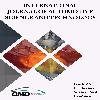A Comparative CFD Study of Side-view Mirror and Side-view Camera Usages on a City Bus
In this study, the effects of classical side mirrors and side-view cameras on the aerodynamic drag coefficient of a city bus model were investigated with Computational Fluid Dynamics (CFD). The surface profile of 1/5 scale bus was modeled with CATIA v5 program. Aerodynamic analyzes were per-formed with ANSYS Fluent® v18. Reynolds Average Navier-Stokes (RANS)-based Reynolds Stress Model (RSM) was used as the turbulence model. The ground effect was taken into consideration in all analyzes. The solution do-main for 5% blockage ratio was created. Inflation layers are used on the ve-hicle surface regarding velocity changes due to viscous effects. The mesh number independence of analyzes was examined for the bus model without side mirrors and provided for 1.3 M mesh element. The Reynolds number in-dependence of the analysis was investigated by using the optimum number of mesh. Free flow velocity of 90 m/s and above were found to be adequate for Reynolds number independence. The drag coefficient was calculated for the bus with side mirrors by using optimum mesh and wind speed as well. The drag coefficients for the bus with side mirrors and side view cameras were de-termined 0.53 and 0.521 respectively.
___
- [1] Wang, J., Bartow, W., Moreyra, A., Woyczynski, G., Lefebvre, A., Carrington, E., & Zha, G. (2014). Low drag automotive mirrors using passive jet flow control. SAE International Journal of Passenger Cars-Mechanical Systems, 7(2014-01-0584), 538-549.
- [2] Gan, J., Li, L., Zha, G., & Czlapinski, C. (2017). Truck Rear View Mirror Drag Reduction Using Passive Jet Boat Tail Flow Control (No. 2017-01-1538). SAE Technical Paper.
- [3] J. Vasanthe Roy,T.Santhosh Kumar, R.Ashish Kumar, S. Jeeva, V. Vinoth Kumar. (2018) “ Aerodynamic Design Improvement for an Intercity Bus” Internal Research Journal of Automotive Technology, Chennai
- [4] İpci D., Yılmaz E., Aysal F.E., Solmaz H.(2015) “ Bir Kara Taşıt Modeli Etrafındaki Akış Yapısının Sayısal Olarak İncelenmesi ”
- [5] Gebel M.E., Önaldı S., Korkmaz S., Osmanoğlu S., Özçelik B., Ermurat M., İmal M., (2018) “ Bir Elektrikli Aracın Aerodinamik Özelliklerinin Deneysel ve Sayısal Olarak İncelenmesi” 9th International Automotive Technologies Congress, OTEKON.
- [6] J Howell, J., Windsor, S., and Le Good, G., “A Novel Test Rig for the Aerodynamic Development of a Door Mirror,” SAE Technical Paper 2006-01-0340, 2006, doi:10.4271/2006-01-0340.
- [7] Hirose, K., Nakagawa, R., Ura, Y., Kawamata, H., Tanaka, H., & Oshima, M. (2015). Application of Prediction Formulas to Aerodynamic Drag Reduction of Door Mirrors (No. 2015-01-1528). SAE Technical Paper.
- [8] Buscariolo, F. F., & Rosilho, V. (2013). Comparative CFD study of outside rearview mirror removal and outside rearview cameras proposals on a current production car (No. 2013-36-0298). SAE Technical Paper.
- [9] Katz, J. (2016). Automotive aerodynamics. John Wiley & Sons.
- [10] Lanfrit M., 2005. “Best practice guidelines for handling Automotive External Aerodynamics with FLUENT” Darmstadt: Fluent Deutschland GmbH.
- [11] ANSYS FLUENT 12.0 Theory Guide - 4.9 Reynolds Stress Model.
- Yayın Aralığı: Yılda 4 Sayı
- Başlangıç: 2016
- Yayıncı: Otomotiv Mühendisleri Derneği
Sayıdaki Diğer Makaleler
Analysis of Design Parameters ofa Novel Modified Reciprocating Mechanism
Multi-Objective Optimization of Biodiesel and Diethyl Ether Doped Diesel Engine by Taguchi Method
Osman Akın Kutlar, Mehmet Ilter Ozmen, Omer Cihan, Cemal Baykara, Osman Azmi Ozsoysal
Seyfi POLAT, Murat Alparslan Güngör
